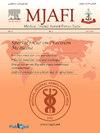考验与磨难:开发人工智能,从外周血涂片中筛查疟原虫
Q2 Medicine
引用次数: 0
摘要
背景:从血液涂片中检测疟疾寄生虫仍然是确诊的金标准。血液涂片筛查疟疾寄生虫的灵敏度为75%,需要对实验室技术人员进行强化培训。在本研究中,我们试图开发一种人工智能来自动化疟疾寄生虫检测过程。方法采集外周血leishman - giemsa染色图像352张,包括正常红细胞和寄生红细胞。通过试错法,我们开发了五种深度学习模型:(a)用于滋养体的朴素深度卷积神经网络(DCNN), (B)改进的Inception V3预训练神经网络(C)模型a和模型B的组合,(D)通过分水岭变换和朴素三类DCNN(正常红细胞、寄生虫红细胞、白细胞/血小板)从图像中分割细胞,以及(E)用于检测环状结构的朴素DCNN模型。将图像随机分为训练集和测试集,对所有模型进行训练。训练完成后,在测试集上评估每个模型的性能。结果总体而言,D模型检测寄生虫的灵敏度和特异度结合最佳,分别为85%和94%;除了滋养体外,模型D还可以探测到环状结构。型号A、B、;C缺乏敏感性或特异性。结论本研究为开发从自动显微摄影/整张幻灯片图像中筛选疟原虫的完整模块迈出了第一步。本文章由计算机程序翻译,如有差异,请以英文原文为准。
Trials and tribulations: Developing an artificial intelligence for screening malaria parasite from peripheral blood smears
Background
Detection of malaria parasite from blood smears remains the gold standard for confirmation of diagnosis. Screening blood smears for malaria parasite has a sensitivity of 75 %, and requires intensive training of the laboratory technician. In the present study, we have attempted to develop an artificial intelligence to automate the process of malaria parasite detection.
Methods
We acquired 352 images of Leishman–Giemsa-stained peripheral blood smears, containing either normal red blood cells (RBCs) or parasitised RBCs. With a trial and error approach, we developed five deep learning models: (A) Naive deep convolutional neural network (DCNN) for trophozoites, (B) Modified Inception V3 pretrained neural network (C) Combination of model A and B, (D) Segmentation of cells from the images through Watershed Transform and naive tri-class DCNN (normal RBCs, parasitised RBCs, WBC/platelets), and (E) A naive DCNN model to detect ring forms. The images were randomly split into training and test sets and training was imparted on all the models. After completion of training, performance of each model was assessed on the test set.
Results
Overall, the best combination of sensitivity and specificity was seen in model D (85 % and 94 %, respectively) in detecting parasites; in addition to trophozoites, model D could also detect ring forms. The performance of model A, B & C suffered from lack of either sensitivity or specificity.
Conclusion
The present study represents the first step towards development of a complete module for screening malaria parasites from automated microphotography/whole slide images.
求助全文
通过发布文献求助,成功后即可免费获取论文全文。
去求助
来源期刊

Medical Journal Armed Forces India
Medicine-Medicine (all)
CiteScore
3.40
自引率
0.00%
发文量
206
期刊介绍:
This journal was conceived in 1945 as the Journal of Indian Army Medical Corps. Col DR Thapar was the first Editor who published it on behalf of Lt. Gen Gordon Wilson, the then Director of Medical Services in India. Over the years the journal has achieved various milestones. Presently it is published in Vancouver style, printed on offset, and has a distribution exceeding 5000 per issue. It is published in January, April, July and October each year.
 求助内容:
求助内容: 应助结果提醒方式:
应助结果提醒方式:


